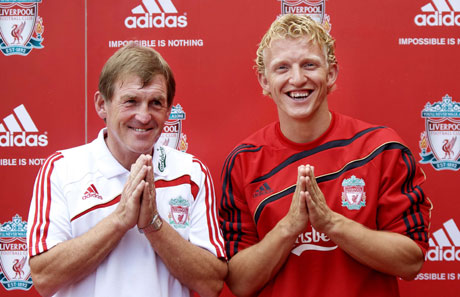-
Recent Articles
The Midfielder as Centerback
 Marcelo Biesla and Josep Guardiola are both managers who play a very high line with their respective sides and who both demand that all players be technically proficient with the ball. Part of playing...
Marcelo Biesla and Josep Guardiola are both managers who play a very high line with their respective sides and who both demand that all players be technically proficient with the ball. Part of playing...Understanding the 4-4-2 Diamond
DEFENCE Despite the fact that there are four ways to play a diamond formation on FM, the differences between them are few and usually subtle. As a starting point, one thing each of them do have...3 at the back and the 4-4-2 Diamond
 Last week Chelsea v Liverpool became the biggest tactical talking point of the season. Liverpool revived the the 3 man defence that Kenny debuted against Stoke. While with the introduction of Torres for £50m...
Last week Chelsea v Liverpool became the biggest tactical talking point of the season. Liverpool revived the the 3 man defence that Kenny debuted against Stoke. While with the introduction of Torres for £50m...How To Set Up A Back Four
 Last year, I wrote a guide about how to play a simple 4-4-2. One of the major components of that is the back four. In fact, most modern formations build upon four defenders; two full backs and two centre...
Last year, I wrote a guide about how to play a simple 4-4-2. One of the major components of that is the back four. In fact, most modern formations build upon four defenders; two full backs and two centre...Building Your Defence: Full Backs
 The modern full back is quickly becoming one of the most important players on the team sheet, infact even back in the days of Brian Clough, fat ed' argued that because of the space these players get in the final...
The modern full back is quickly becoming one of the most important players on the team sheet, infact even back in the days of Brian Clough, fat ed' argued that because of the space these players get in the final...
JOIN 12,748 READERS - SUBSCRIBE NOW TO OUR FOOTBALL MANAGER NEWSLETTER
Get the latest FM news & best community content delivered directly to your e-mail inbox!
Tactical Bible ’08: RoO/RoT For Dummies
Written by: Gareth Millward
Category: Formations
Posted on: May 31, 2007
May 31, 2007
Rule of One/Two for Dummies
Requested topic
One of the most prevalent theories in Football Manager over the past couple of seasons has been wwfan’s Rule of One (RoO) and its predecessor Rule of Two (RoT). Originally, it was designed to space out the players on the park so that they had enough room to breathe, whilst at the same time keeping the team compact as a unit. In FM06, this was acheived by keeping each player roughly within two mentality “notches” of at least one other player (RoT), but match engine developments mean that FM07 tactics tend to keep this gap down to one “notch” (RoO).
Using this system, the user can create a number of mentality frameworks, and these are the building blocks of most TT&F tactics. In short, each position should be within one notch of another. For the most defensive 4-4-2 with a basic RoO setup, therefore, we should end up something like this:
GK: 1
DC: 2
FB: 3
MCd: 4
ML/R: 5
MCa: 6
FC: 7
Note that for the purposes of a RoO 4-4-2, the central midfield is split between a more defensive holding midfielder and a more attacking one to give both flexibility and solidity to the formation. The wingers are given mentalities in between these two to give more of a “diamond” kind of shape to the formation, whilst still keeping a flat midfield (at least on the formations screen).
From this most defensive set up, we can scale up to become slightly more attacking each time until our goalkeeper reaches 14:
GK: 14
DC: 15
FB: 16
MCd: 17
ML/R: 18
MCa: 19
FC: 20
To put it most simply of all, RoO was originally designed to use this most attacking framework (14) at home and the most defensive framework (1) away. By creating other frameworks in between, and using the other instructions we have discussed in other articles, you can create a range of tactics suited to any situation and with any team. RoO offers all the options of a slider, and yet has an advantage over the AI because it is staggered, and therefore keeps the best of both worlds - tight formation and flexible positioning.
Of course, these are not hard and fast rules that must be obeyed, and clearly this is only an outline for a 4-4-2. Some choose to play with split FCs (particularly if playing the classic “little and large” striker combo), some choose to split their DCs. It’s really up to the individual player, but these frameworks offer a solid guide upon which to build.
In RoO, DL and DR are usually on the same mentality, and the same is true of WBL/R, ML/MR, AML/R and FL/R, depending on your system. Splitting the central players is up to the individual, though MCd and MCa are almost always used since they offer the most flexibility. A lot of the Tactical Bible guides are also written with this distinction in mind.
But I’m not playing 4-4-2!
RoO was designed for 4-4-2, but can be used in other systems to great effect. Providing a player has options available, he should fit into the system. Try, at all times, to keep at least one player within one notch of another. For example, a 4-1-2-3 system may look like this:
GK: 1
DC: 2
FB: 3
DM: 4
MC: 5
AML/R: 6
FC: 7
Note that in this system, it is not necessary to split the MCs into MCa/d if you don’t want to because the DM fulfills this role. Of course, there’s nothing to stop you from having this split, but the beauty of having a true holding player is that your MCs are free to concentrate on attacking.
Further Considerations
The Tactical Bible has outlined many of the approaches which go with these systems, but it is important to mention, in brief, a few settings which are closely tied to your chosen mentality framework.
Defensive Line - Defensive line is usually taken at the average point of the framework - i.e., on the away framework (1-7) you set the d. line at the median value (4), and increase it as you increase the framework. Of course, you may want to lower or raise this value based on your style of play, speed of your DCs etc. etc. However, once you are facing very defensive formations you will need to break this link and lower the d-line in attacking systems to open more space on the pitch.
Width - Width is often linked to mentality as well, but not always. However, it is usually considered to be the same as the defensive line (in the away example this would be 4 again). This guideline is now regularly broken by most tacticians as it doesn’t give much tactical flexibility, but it is a good guide as a starting point for you to modify as you see fit.
Time Wasting - This usually mirrors width and defensive line. In the away framework this would be 16, since this is the opposite of the width (4 notches from the right, rather than 4 notches from the left).
Team Mentality - RoO assumes that individual mentality is not affected by team mentality. Therefore, leave the team mentality slider on 10, unless going all out attack (22) or ultra-defensive (1).
Tactical Bible Credits
wwfan, The next Diaby. Written by Millie
About The Author: Gareth Millward
Member of the FM-B Think Tank and one of the main authors and editors of FM-B’s tactical guides and e-books, Millie organises the content for the main site. He has a particular interest in the history of football tactics (probably because in real life he is an historian) and in recreating real-world football in the FM match engine.
Download Our Tactical Theorems '10 eBook Absolutely Free

Presenting the most comprehensive tactic design and match strategy guide to the Football Manager series ever created!
Written by FM match engine beta testers, it's 60+ pages of easy-to-read concepts and ideologies for getting your team playing exactly how you want each match! It's been downloaded over 100,000+ times to date!
Find out more information about our tactical eBook
and download Tactical Theorems '10 right now!
Written by FM match engine beta testers, it's 60+ pages of easy-to-read concepts and ideologies for getting your team playing exactly how you want each match! It's been downloaded over 100,000+ times to date!
and download Tactical Theorems '10 right now!
Web discoveries
- UK Casinos Not On Gamstop
- Online Casinos UK
- Best Slot Sites
- Non Gamstop Casinos
- Casino Sites Not On Gamstop
- UK Online Casinos Not On Gamstop
- Slots Not On Gamstop
- Non Gamstop Casino UK
- Non Gamstop Casino UK
- Casino Sites Not On Gamstop
- UK Online Casinos Not On Gamstop
- Casinos Not On Gamstop
- Gambling Sites Not On Gamstop
- Non Gamstop Casinos
- Non Gamstop Casinos
- Non Gamstop Casino UK
- UK Casino Not On Gamstop
- Casino Sites Not On Gamstop
- UK Online Casinos Not On Gamstop
- UK Online Casinos Not On Gamstop
- Brand New Casinos Not Blocked By Gamstop




